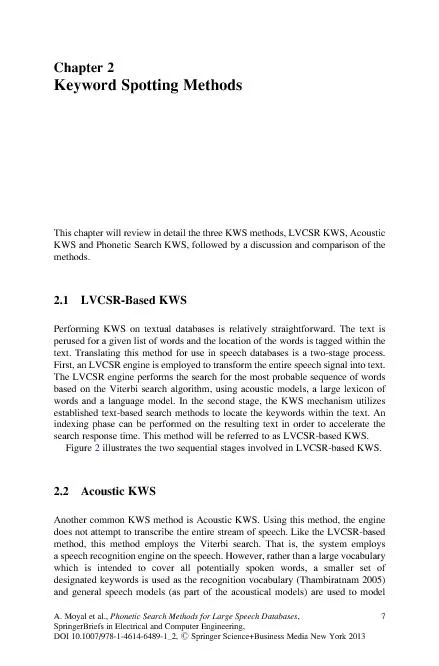

nonkeywordspeechSzokeetal2005ThusacousticKWScanbeperformedinonlyonestageasillustratedinFig23PhoneticSearchKWSAsitsnamesuggestsphoneticsearchKWSutilizesaphoneticsearchengineIntherststageap ID: 435032
Download Pdf The PPT/PDF document "Chapter2KeywordSpottingMethodsThischapte..." is the property of its rightful owner. Permission is granted to download and print the materials on this web site for personal, non-commercial use only, and to display it on your personal computer provided you do not modify the materials and that you retain all copyright notices contained in the materials. By downloading content from our website, you accept the terms of this agreement.
Chapter2KeywordSpottingMethodsThischapterwillreviewindetailthethreeKWSmethods,LVCSRKWS,AcousticKWSandPhoneticSearchKWS,followedbyadiscussionandcomparisonofthemethods.2.1LVCSR-BasedKWSPerformingKWSontextualdatabasesisrelativelystraightforward.Thetextisperusedforagivenlistofwordsandthelocationofthewordsistaggedwithinthetext.Translatingthismethodforuseinspeechdatabasesisatwo-stageprocess.First,anLVCSRengineisemployedtotransformtheentirespeechsignalintotext.TheLVCSRengineperformsthesearchforthemostprobablesequenceofwordsbasedontheViterbisearchalgorithm,usingacousticmodels,alargelexiconofwordsandalanguagemodel.Inthesecondstage,theKWSmechanismutilizesestablishedtext-basedsearchmethodstolocatethekeywordswithinthetext.Anindexingphasecanbeperformedontheresultingtextinordertoacceleratethesearchresponsetime.ThismethodwillbereferredtoasLVCSR-basedKWS.illustratesthetwosequentialstagesinvolvedinLVCSR-basedKWS.2.2AcousticKWSAnothercommonKWSmethodisAcousticKWS.Usingthismethod,theenginedoesnotattempttotranscribetheentirestreamofspeech.LiketheLVCSR-basedmethod,thismethodemploystheViterbisearch.Thatis,thesystememploysaspeechrecognitionengineonthespeech.However,ratherthanalargevocabularywhichisintendedtocoverallpotentiallyspokenwords,asmallersetofdesignatedkeywordsisusedastherecognitionvocabulary(Thambiratnam2005)andgeneralspeechmodels(aspartoftheacousticalmodels)areusedtomodelA.Moyaletal.,PhoneticSearchMethodsforLargeSpeechDatabasesSpringerBriefsinElectricalandComputerEngineering,DOI10.1007/978-1-4614-6489-1_2,SpringerScience+BusinessMediaNewYork2013 non-keywordspeech(Szokeetal.2005).Thus,acousticKWScanbeperformedinonlyonestage,asillustratedinFig.2.3PhoneticSearchKWSAsitsnamesuggests,phoneticsearchKWSutilizesaphoneticsearchengine.Inthe rststage,aphonemedecoderisemployedoncetotransformthespeechinputintoatextualsequence.However,ratherthanproducingastringofwords,thedecodertransformsthespeechsignalintoastring(orlattice)ofphonemes(Amiretal.2001; Second stage - Keyword DetectionKnowledge SourcesAcousticModelsLanguageModelLexiconDecoderFront-EndProcessingInputSpeechAcousticfeature vectorsKeywordsequencesKeywordDetectionKeywordListRecognizedword sequence Fig.2AnLVSCRkeywordspottingsystemone-timetransformationofaspeechdatabase(DB)intoatextualwordDBandKWSengine ProcessingInputSpeechKnowledge SourcesAcousticfeature vectorsKeywordsequencesDecoder AcousticModelsKWPronunciation Fig.3Anacoustickeywordspottingsystem82KeywordSpottingMethods YuandSeide2004;ThambiratnamandSridharan2005).Inthesecondstage,thephoneticsearchengineemploysadistancemeasuretocomputethetextualdistancebetweenthephonemesequencesthatcorrespondtothekeywordvocabularyandthephonemesequenceswithinthephonemestring(Alon2005).AsshowninFig.,thephoneticsearchengineusestwotypesofinputdata:alistofkeywords,whereeachwordisrepresentedbyasequenceofphonemes,andaspeechdatabasewhichhasbeenrunthroughaphonemedecodertoproduceasequenceofrecognizedphonemes.2.4Discussion:WhyPhoneticSearch?EachofthethreeKWSmethodspresentedabovehasadvantagesandshortcomings.Thecrucialparameterstoevaluateareresponsetime,KWSperformance,andkeyword exibility(JamesandYoung1994;DharanipragadaandRoukos2002;Mamouetal.2007;ThambiratnamandSridharan2007;Schneider2011).2.4.1ResponseTimeIntermsofoverallcomputationalcomplexity,LVCSR-basedKWSandphoneticsearchKWSbothimplementadoublestageprocess:(1)transformationofspeechtotext(wordsequencesinthecaseofLVCSRandphonemesequencesinthecaseofphoneticsearch)and(2)akeywordsearch(word-basedinthecaseofLVCSRandphoneme-basedinthecaseofphoneticsearch).Acoustic-basedKWS,ontheotherhand,isperformedinonestageandoperatesonthespeechitselfwithnotextual AcousticModels PhonemeLMInputSpeech DBPhonemeDecoderTextual PhonemeSequence DBPhonetic SearchKWS EngineKeywordhypotheses KW List Fig.4Aphoneticsearchsystemone-timetransformationofaspeechDBtoatextualphonemeDBandKWSphoneticsearchengine2.4Discussion:WhyPhoneticSearch?9 transformation.AlthoughakeywordsearchthatisimplementedonfullytranscribedtextintheLVCSRmethodisfast(particularlyifthetexthasalsobeenindexed),itisusuallyatadisadvantageincomparisontothephoneticsearchandacousticmethodsduetothefactthatanLVCSRenginedemandsalargevocabularyandacomplexlanguagemodeltoproducerecognitionresults,thusresultinginahighlevelofcomplexityduringthepre-processingstage.Thephoneticsearchmethodperformsphonemerecognitionusingphonemetransitionprobabilities(di-phones)withnolexiconorwordlevellanguagemodel.Duringthesearchstage,however,phoneticsearchKWSusesatextualsequencedistancemeasurethatrequiresmorecomputation.Thisisbecausethephoneticsearchmustgenerateword-levelhypothesesbasedonphonemesequences,whileinLVCSR-basedKWSthetextualoutputisalreadyword-level(Burgetetal.2006).Incontrast,theacoustic-basedKWSusesavocabularyconsistingonlyofthekeywordsanddoesnotrequirealanguagemodelatall.Becausetheacoustic-basedmethodoperatesonthespeechitselfandrequiresonlyasmallvocabulary,itisappropriateforreal-timekeywordspottingorKWSinsmallspeechdatabases.However,thismeansthatgeneralspeechmustbewell-modeled(Thambiratnam2005)toavoidextensiveoverdetection(falsealarms).2.4.2KWSPerformanceThespontaneousspeechandpoorrecordingqualityofspeechdatabasesoftenleadstode cientLVCSRperformance(Butzbergeretal.1992;Cardilloetal.2002).Thelargenumberofdis uencies,includingmispronouncedwords,falsestarts, lledpauses,overlappingspeech,speakernoisesandbackgroundnoisefoundinsponta-neousspeech(Butzbergeretal.1992;GishriandSilber-Varod2010)oftenresultsinoutputsstrewnwithwordinsertions,deletionsandsubstitutions.Thusthemostprobablewordsequencesproducedbytheenginemaynotadequatelyre ecttheactualinputspeech.This,inturn,affectsthereliabilityofthekeywordsearch.Thesameistruewithregardtophoneticsearchresults.Poorphonemerecogni-tionmayyieldlowerkeywordrecognitionperformanceincomparisonwiththeacousticKWSmethod,whichworksonthespeechitselfbysearchingforaspeci csequenceofphonemeswithouttextualtransformation.2.4.3KeywordFlexibilityIncomparisontothephoneticsearchmethod,whichrunsonsequencesofphonemesratherthanwords,theLVCSRmethodisatadisadvantagewhenitcomestokeyword exibility(Cardilloetal.2002;Burgetetal.2006;Wallaceetal.2007).Usingthephoneticsearchmethodallowsapplicationuserstotalfreedominchangingthedesignatedkeywords,sincethetextualtransformationintophonemes102KeywordSpottingMethods isnotrestrictedbyavocabulary.Addingnewkeywordsisasimpleprocedurethatentailsre-runningthephoneticsearchonthephonemesequences,butdoesnotrequirere-runningthephonemedecoder.ThetextualtransformationproducedbyanLVCSRengine,ontheotherhand,isconstrainedbytherecognitionvocabularyandthelanguagemodelemployed.Thus,unlessthedesignatedkeywordswerepartoftheoriginalrecognitionvocabulary,theycannotbechangedwithoutrepeatingtherecognitionprocess(Clementsetal.2001;Cardilloetal.2002;Szokeetal.2005;MamouandRamabhadran2008).Sincekeywordsareinmanycasesnamesordomain-speci cvernacular,theyareoftennotfoundinstandardlexicons(Wallaceetal.2007;GishriandSilber-Varod2010).ThisisasubstantialshortcomingoftheLVCSRmethod.Acoustic-basedKWSalsorepresentsanimpracticalsolutionforsearchinglargedatabasesthatrequirerapidand exiblesearchingcapabilities.Becauseitconsistsofonlyonestage,theentireprocessneedstobere-runonthespeechdatabaseeachtimeanewkeyworddictionaryisintroduced.Themajorityofapplicationsrequirekeyword exibility,aswellastheshortestpossibleresponsetimewhensearchingverylargespeechdatabases,makingthephoneticsearchKWSmethodmoreattractivethantheLVCSRandacoustic-basedoptionswhensearchingverylargespeechdatabases.Thus,thefocusofthefollow-ingchapterswillbeonphoneticsearchKWS,andtheimplementationofanalgorithmforthereductionofcomputationalcomplexityinthephoneticsearchKWSprocess.2.4Discussion:WhyPhoneticSearch?11